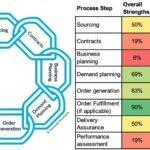A perennial favorite topic in procurement is category management. It’s one of the first steps in improving an organization’s supply chain maturity and is a huge step in going from a purchasing team of PO-cutters and expediters to building real, strategic, long-term value. So what does a team of procurement professionals need to do to actually make that leap from purchasing to category management? I would argue a key ingredient is the category strategy, which must be written, vetted, and constantly updated. Today let’s talk about what a category strategy is (and is not), what goes into a category strategy, and how to maintain a strategy’s relevance as part of a larger supply chain ecosystem.
What is a Category Strategy (and What isn’t)
The purpose of a category strategy is simple: to lay out, in the clearest possible terms, all aspects of managing a particular category of goods or services a company buys. It includes supplier information, spend, internal and external forces affecting that category, and how the company/category manager plans to approach this spend to maximize company value.
A category strategy doesn’t exist until it’s written and shared. The approach “Matt has that in his head and knows what he’s doing” doesn’t count. A file on a personal computer that no one else is allowed to look at (or maybe doesn’t even know exists) doesn’t count. A category strategy certainly doesn’t have to be printed on paper, but the rest of the supply chain team has to have access to the information to account for it in their own category strategies, be able to cover for one another, and generally build a full category management team.
A category strategy is part of onboarding for a new category manager. Whether that person came in from outside the company or was promoted from buyer to category manager, the category strategy should clearly provide them what they need to know from day one. For an experienced category manager, being handed a stack of category strategies on their first day will get them 90% of what they need to take off running and build value quickly. Even if they proceed to change all of it (and they likely will), they will know where they start.
A category strategy is constantly under attack, both externally and internally. Externally, market forces and suppliers are continuously shifting and changing, which can invalidate a strategy very quickly. Internally, technical teams and other supply chain team members are modifying specifications and influencing their own categories that in turn change other category strategies. In order to counter these attacks, a category strategy must be a continuously improving living document.
A category strategy is subject to the personality of its category manager. This may sound a little odd, but don’t force category strategies to be so static and so cookie-cutter that they lose all personality. A huge part of what a category manager brings to the job is their unique skills and talents, so ensure the category strategy is flexible enough to allow for those differences. Some category managers are very good at negotiation, some are excellent at data analysis, and some are good at getting buy-in. When a category strategy is handed from one manager to another, expect changes based on these personality and skill differences.
A category strategy is not static. As already noted, it needs to grow and change in response to internal and external forces, and needs to continuously improve. Don’t simply write category strategies and put them on a shelf; more on maintaining them later in this article.
A category strategy is not only relevant to the supply chain team. It’s important that stakeholders get some input and say in a category strategy, especially when it comes to supplier performance, and a strategy that only reflects procurement’s opinions is severely limited. A procurement-only approach leads to groupthink and doesn’t help build relationships with stakeholders.
Components of a Category Strategy
Here is a potential list of items to include in a category strategy, with a brief explanation of each. Cater this list to your own needs and company.
Category name/number: This is based on your own company’s category taxonomy, whether UNSPSC, NAICS, some other taxonomy, or one customized to your business.
Subcategories included: Subcategories might include specific sizes for very large categories, which subcategories are covered by the strategy, etc. For example, the category is sheet steel and the subcategories are all sizes less than 20 gauge in thickness. Sheet steel thicker than 20 gauge might be on a different category strategy.
Category manager: Don’t forget to keep ownership and accountability as part of the category strategy, and that means including who owns that strategy.
Spend: Include a breakdown of the spend for this category, by subcategory or plant location if relevant. How big is the category and what is its impact on your business?
Executive summary: This should go almost first in the strategy, but write it last. It is simply a summary of the strategy and is the “if you read only one thing, read this” for anyone wanting to get to the heart of the strategy quickly. More on writing an executive summary in this article.
Contract deadline: When does a new contract need to be signed next for this category? This helps you calculate timing for the other activities on the strategy (RFI, RFP, negotiation, etc.).
Supplier List: Include contact information, even if you have a supplier database somewhere. Consider including different supplier groups: incumbent suppliers, new suppliers to invite, and suppliers eliminated from bidding for one reason or another (couldn’t pass an audit, cannot provide the full category according to the preferred award scenario, etc.).
Relevant commodity index: What third-party index (or indices) govern this category? Steel? Labor? Software? More on category indices and index-linking in this article.
Supplier power and buyer power: If you are using a Kraljic matrix or Kearney chessboard approach to help set strategy, figure out where you are on that matrix and include your logic as to why in the strategy.
Basic strategy: This is the heart of the category strategy, whether using Kraljic, Kearney, or another method. Outline where the value is (Lead time? Price? Customer service?) and how best to get that value (Negotiation? E-auction? RFP? Some combination thereof?). Remember someone else should be able to pick up this document and understand the approach, whether they can personally replicate it or not.
Internal considerations and risks: Consider the internal forces on this category, and give them a rating for likeliness and severity. How likely are they to happen and how bad is it if they do? This will help you focus your efforts on risk mitigation using contract terms, scope of work requirements, software auditing/monitoring, or other risk mitigation options. Some things that might be on your internal considerations list are: internal political considerations (is one of the suppliers the personal friend of an executive?), IT issues, geography/location considerations, certification requirements, safety requirements, history of not approving certain suppliers, and technical team sentiment toward incumbent suppliers.
External considerations and risks: Just like with internal considerations, rate external issues for likeliness and severity. Some items that might be on the external considerations include: need for business continuity plans (if we have another COVID, does your whole business shut down without this category?), cybersecurity audits, financial reports (i.e. Dun & Bradstreet), political situation in countries of origin, market volatility, labor issues, global trade issues (tariffs, anyone?), “force majeure” sensitivity such as hurricanes, floods, storms, droughts, wildfires, etc., monopolies/limited number of suppliers in the market, limited second tier suppliers, and whether key materials are being used in competing industries (i.e. the utility industry and electric vehicle industry both competing for grain-oriented electrical steel).
Risk mitigation plan: For the top risks identified internally and externally, what will you do about them? How can you prevent issues from occurring, or what will you do if they happen?
Contract leakage: If you have the ability to pull the information, has the business unit historically awarded work or spent money with a supplier other than the selected one in this category (aka Maverick spend)? If so, why? And what will you do about it? It may completely change your strategy if the real issue is having a business unit align with your goals.
Proposed contract: This includes both length and type of contract. Is this a one-year award? A three-year relationship? And which contract template will you use? PO terms? A full materials contract? Do you expect this contract to instead be on supplier paper?
Price change strategy: How will suppliers be allowed to change their prices? Will you index-link pricing and change quarterly or biannually? Or perhaps you expect the supplier to set their pricing per year over the next three years. I do not recommend having a supplier set three-year pricing in year one and have them stick to it. This is because you will end up paying the third-year price for three years. My personal favorite for most categories is to set year one, year two, and year three prices but then require the supplier to justify those prices each year if they want increases. For me, this is the best balance of risk and cost in many categories.
Reporting/data requirements: This starts to become a scope of work item, but consider what kind of data you need suppliers to provide and what you will do with it. Don’t gather data simply to gather it, have a plan for how it is actionable and useful.
Target savings: Many supply chain or procurement teams are measured on savings constantly, so include the savings goal in a category strategy. The strategy itself covers how you will achieve those savings, but don’t forget to align the category strategy with your supply chain metrics (including savings) to keep the team moving in the same direction.
Maintain Relevance
Now that you’ve written the category strategy, make sure it stays relevant. As mentioned earlier, it’s constantly under attack, so I always prefer to deal with those attacks in a planned, controlled way and make them constructive. Have a regular review (quarterly, biannually, or annually) of category strategies. The audience needs to include at least supply chain leadership, but also include the key technical teams and business units who use this category most. Allow them to offer constructive feedback to the category, how it has been running, whether they are seeing desired value, etc. Provide a supportive structure to the category manager, but use these internal reviews to make each strategy better and stronger.
I helped one of my clients train their team (who was fairly new to category management or procurement in general) in category strategies, build a category strategy template based on their specific company and industry, and then go through their category strategy first drafts one-on-one to really improve their ability to approach the supply chain strategically. If that sounds like your team or you’d like to talk through your category strategies, let’s chat. If you’d like to get these articles weekly straight to your inbox and never miss one, sign up for my newsletter.
My book, Transform Procurement: The Value of E-auctions is now available in ebook, paperback and even hardcover format: https://www.amazon.com/dp/B0F79T6F25




